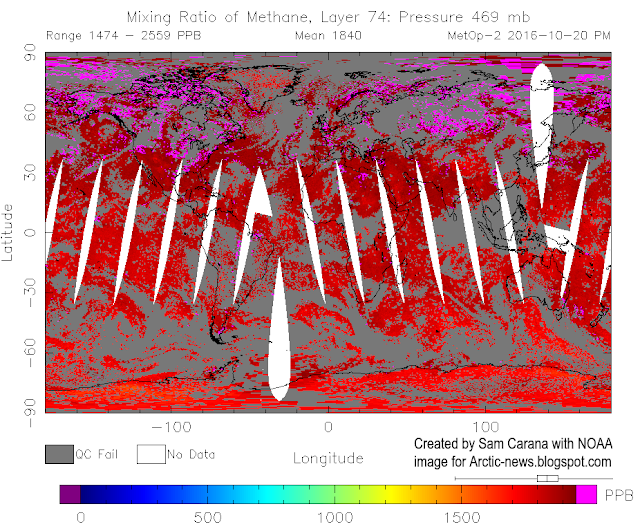The currently very low sea ice extent is further dragging down the average annual sea ice extent, which is also at a record low, as illustrated by the image below, from the blog by Torstein Viðdalr.
Not only is Arctic sea ice extent very low, the sea ice is getting thinner and thinner, as illustrated by the image below, by Wipneus, showing the dramatic recent decline of Arctic sea ice thickness.
As the Naval Research Lab 30-day animation below shows, Arctic sea ice isn't getting much thicker, despite the change of seasons.
 |
| Naval Research Lab 30-day animation (new model) up to Nov 1, 2016, with forecast up to Nov 9, 2016 |
Paul Beckwith: "Arctic sea ice regrowth is eff'd this year, in fact is truly horrible. As the ice extent, defined as regions with at least 15% ice, tries to expand via sea water freezing, it is melted out by extremely high sea surface temperatures. Then the cooled surface water mixes via wave action with warmer water down to as much as 200 meters and the warm mixtures at the surface continue the process of sea ice melting. Without strong ice regrowth, we will reach the state we are heading to. Namely, zero sea ice. We must break this vicious cycle, by declaring a global climate emergency, and implementing the three-legged-stool solution set."
As global warming raises the temperature of the sea surface and the atmosphere over the sea surface, ever stronger winds develop, in turn resulting in stronger waves and higher amounts of water in clouds.
The image below shows forecasts for November 9, 2016, of waves as high as 13.76 m (green circle, left panel) and of total amounts of water (from surface to space) as much as 1.38 kg/m² (green circle right panel, near Novaya Zemlya).
 |
| [ click on images to enlarge ] |
The dire state of the sea ice indicates that the water of the Arctic Ocean is getting warmer and warmer.
On October 31, 2016, the Arctic Ocean was as warm as 17°C or 62.7°F (green circle near Svalbard), or 13.9°C or 25°F warmer than 1981-2011. This indicates how much warmer the water is beneath the surface, as it arrives in the Arctic Ocean from the Atlantic Ocean.
Below is an update of the situation on methane. Contained in existing data is a trend indicating that methane levels could increase by a third by 2030 and could almost double by 2040.
Why is methane so important? On a 10-year timescale, methane causes more warming than carbon dioxide. Unlike carbon dioxide, methane's Global Warming Potential rises as more of it is released. Methane's lifetime can be extended to decades, in particular due to depletion of hydroxyl in the atmosphere.
Ominously, the image below shows that on November 9, 2016, methane levels were very high over the Laptev Sea (solid magenta color north of Siberia).
The image below shows that methane levels on November 9, 2016, were as high as 2633 parts per billion (at a slightly higher altitude corresponding to a pressure of 469 mb).
Temperatures over the Arctic Ocean are forecast to remain high, reflecting the very high temperature of the water.
The danger is that, as global warming continues and as the Arctic snow and ice cover keeps shrinking, warming of the Arctic Ocean will speed up and destabilize methane hydrates contained in sediments at its seafloor, triggering huge methane eruptions that will further accelerate warming. This could contribute to make global temperature rise by as much as 10°C or 18°F over the coming decade.
The danger is that, as global warming continues and as the Arctic snow and ice cover keeps shrinking, warming of the Arctic Ocean will speed up and destabilize methane hydrates contained in sediments at its seafloor, triggering huge methane eruptions that will further accelerate warming. This could contribute to make global temperature rise by as much as 10°C or 18°F over the coming decade.
The situation is dire and calls for comprehensive and effective action, as described in the Climate Plan.






































